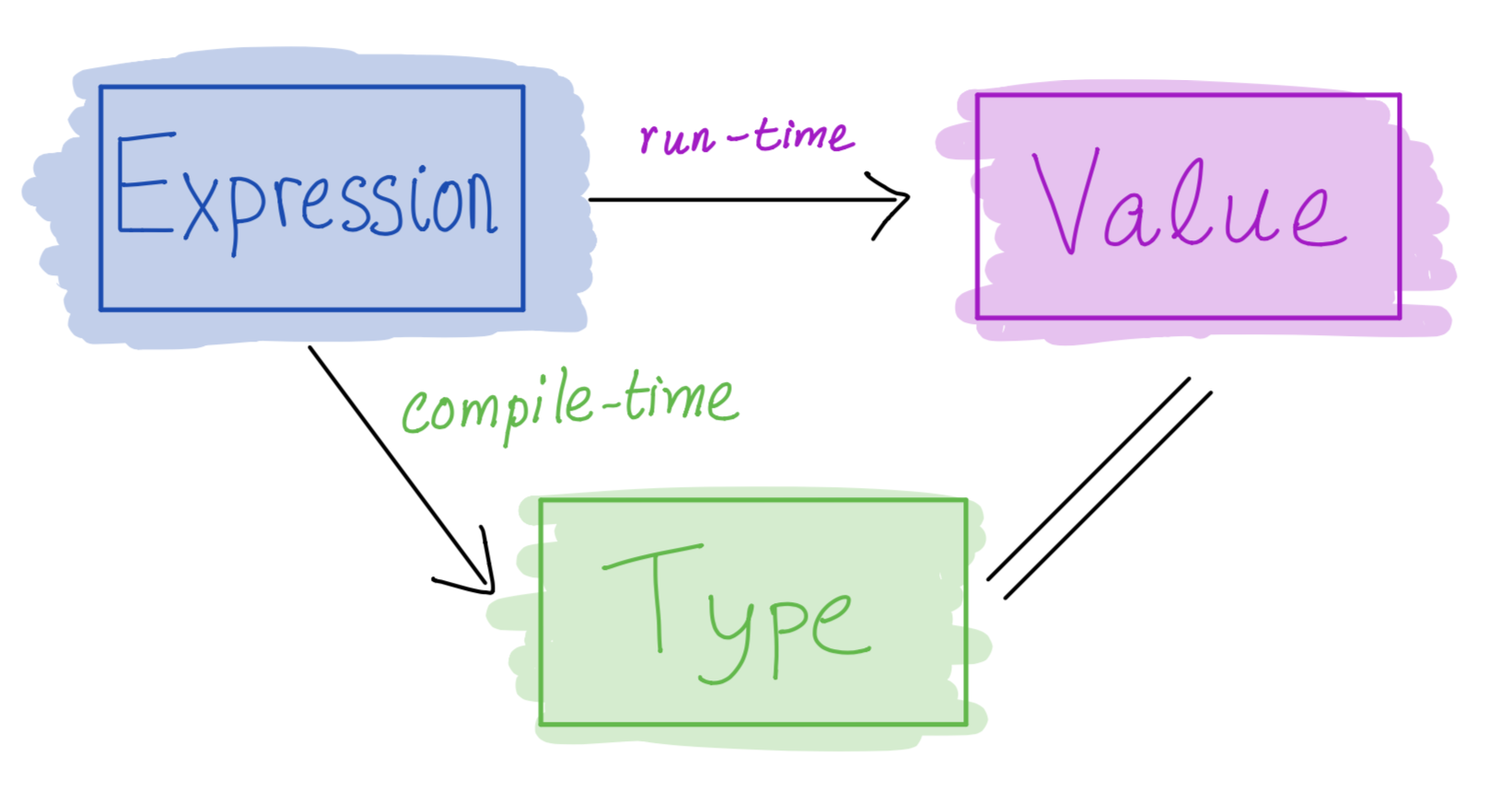From the Lambda Calculus to Haskell
Programming in Haskell
Computation by Calculation
Substituting equals by equals
Computation via Substituting Equals by Equals
(1 + 3) * (4 + 5)
-- subst 1 + 3 = 4
==> 4 * (4 + 5)
-- subst 4 + 5 = 9
==> 4 * 9
-- subst 4 * 9 = 36
==> 36
Computation via Substituting Equals by Equals
Equality-Substitution enables Abstraction via Pattern Recognition
Abstraction via Pattern Recognition
Repeated Expressions
Recognize Pattern as λ-function
Equivalent Haskell Definition
Function Call is Pattern Instance
pat 31 42 56 =*> 31 * (42 + 56) =*> 31 * 98 =*> 3038
pat 70 12 95 =*> 70 * (12 + 95) =*> 70 * 107 =*> 7490
pat 90 68 12 =*> 90 * (68 + 12) =*> 90 * 80 =*> 7200Key Idea: Computation is substitute equals by equals.
Programming in Haskell
Substitute Equals by Equals
Thats it! (Do not think of registers, stacks, frames etc.)
Elements of Haskell

- Core program element is an expression
- Every valid expression has a type (determined at compile-time)
- Every valid expression reduces to a value (computed at run-time)
Ill-typed* expressions are rejected at compile-time before execution
- like in Java
- not like λ-calculus or Python …
The Haskell Eco-System
Batch compiler:
ghcCompile and run large programsInteractive Shell
ghciShell to interactively run small programs onlineBuild Tool
stackBuild tool to manage libraries etc.
Interactive Shell: ghci
A Haskell Source File
A sequence of top-level definitions x1, x2, …
Each has type
type_1,type_2, …Each defined by expression
expr_1,expr_2, …
Basic Types
ex1 :: Int
ex1 = 31 * (42 + 56) -- this is a comment
ex2 :: Double
ex2 = 3 * (4.2 + 5.6) -- arithmetic operators "overloaded"
ex3 :: Char
ex3 = 'a' -- 'a', 'b', 'c', etc. built-in `Char` values
ex4 :: Bool
ex4 = True -- True, False are builtin Bool values
ex5 :: Bool
ex5 = False
QUIZ: Basic Operations
ex6 :: Int
ex6 = 4 + 5
ex7 :: Int
ex7 = 4 * 5
ex8 :: Bool
ex8 = 5 > 4
quiz :: ???
quiz = if ex8 then ex6 else ex7What is the type of quiz?
A. Int
B. Bool
C. Error!
QUIZ: Basic Operations
ex6 :: Int
ex6 = 4 + 5
ex7 :: Int
ex7 = 4 * 5
ex8 :: Bool
ex8 = 5 > 4
quiz :: ???
quiz = if ex8 then ex6 else ex7What is the value of quiz?
A. 9
B. 20
C. Other!
Function Types
In Haskell, a function is a value that has a type
A function that
- takes input of type
A - returns output of type
B
For example
Define function-expressions using \ like in λ-calculus!
But Haskell also allows us to put the parameter on the left
(Meaning is identical to above definition with \n -> ...)
Multiple Argument Functions
A function that
- takes three inputs
A1,A2andA3 - returns one output
Bhas the type
For example
which we can write with the params on the left as
QUIZ
What is the type of quiz ?
A. Int -> Int
B. Int -> Bool
C. Int -> Int -> Int
D. Int -> Int -> Bool
E. (Int, Int) -> Bool
Function Calls
A function call is exactly like in the λ-calculus
where e1 is a function and e2 is the argument. For example
Multiple Argument Calls
With multiple arguments, just pass them in one by one, e.g.
For example
EXERCISE
Write a function myMax that returns the maximum of two inputs
When you are done you should see the following behavior:
How to Return Multiple Outputs?
Tuples
A type for packing n different kinds of values into a single “struct”
For example
QUIZ
What is the type ??? of tup3?
A. (Int, Bool)
B. (Int, Double, Bool)
C. (Int, (Double, Bool))
D. ((Int, Double), Bool)
E. (Tuple, Bool)
Extracting Values from Tuples
We can create a tuple of three values e1, e2, and e3 …
… but how to extract the values from this tuple?
Pattern Matching
fst3 :: (t1, t2, t3) -> t1
fst3 (x1, x2, x3) = x1
snd3 :: (t1, t2, t3) -> t2
snd3 (x1, x2, x3) = x2
thd3 :: (t1, t2, t3) -> t3
thd3 (x1, x2, x3) = x3
QUIZ
What is the value of quiz defined as
tup2 :: (Char, Double, Int)
tup2 = ('a', 5.2, 7)
snd3 :: (t1, t2, t3) -> t2
snd3 (x1, x2, x3) = x2
quiz = snd3 tup2A. 'a'
B. 5.2
C. 7
D. ('a', 5.2)
E. (5.2, 7)
Lists
Unbounded Sequence of values of type T
For example
chars :: [Char]
chars = ['a','b','c']
ints :: [Int]
ints = [1,3,5,7]
pairs :: [(Int, Bool)]
pairs = [(1,True),(2,False)]
QUIZ
What is the type of things defined as
A. [Int]
B. ([Int], [Int], [Int])
C. [(Int, Int, Int)]
D. [[Int]]
E. List
List’s Values Must Have The SAME Type!
The type [T] denotes an unbounded sequence of values of type T
Suppose you have a list
There is no T that we can use
- As last element is not
Int - First two elements are not
Char!
Result: Mysterious Type Error!
Constructing Lists
There are two ways to construct lists
For example
Cons Operator : is Right Associative
x1 : x2 : x3 : x4 : t means x1 : (x2 : (x3 : (x4 : t)))
So we can just avoid the parentheses.
Syntactic Sugar
Haskell lets you write [x1, x2, x3, x4] instead of x1 : x2 : x3 : x4 : []
Functions Producing Lists
Lets write a function copy3 that
- takes an input
xand - returns a list with three copies of
x
When you are done, you should see the following
PRACTICE: Clone
Write a function clone such that clone n x returns a list with n copies of x.
When you are done you should see the following behavior
>>> clone 0 "cat"
[]
>>> clone 1 "cat"
["cat"]
>>> clone 2 "cat"
["cat", "cat"]
>>> clone 3 "cat"
["cat", "cat", "cat"]
>>> clone 3 100
[100, 100, 100]
How does clone execute?
(Substituting equals-by-equals!)
EXERCISE: Range
Write a function range such that range i j returns the list of values [i, i+1, ..., j]
When we are done you should get the behavior
>>> range 4 3
[]
>>> range 3 3
[3]
>>> range 2 3
[2, 3]
>>> range 1 3
[1, 2, 3]
>>> range 0 3
[0, 1, 2, 3]
Functions Consuming Lists
So far: how to produce lists.
Next how to consume lists!
Example
Lets write a function firstElem such that firstElem xs returns the first element xs if it is a non-empty list, and 0 otherwise.
When you are done you should see the following behavior:
QUIZ
Suppose we have the following mystery function
What does mystery [10, 20, 30] evaluate to?
A. 10
B. 20
C. 30
D. 3
E. 0
EXERCISE: Summing a List
Write a function sumList such that sumList [x1, ..., xn] returns x1 + ... + xn
When you are done you should get the following behavior:
Recap

- Core program element is an expression
- Every valid expression has a type (determined at compile-time)
- Every valid expression reduces to a value (computed at run-time)
Execution
Basic values & operators
Execution / Function Calls just substitute equals by equals
Pack data into tuples & lists
Unpack data via pattern-matching
